Viśākhā—I Want It All and I Want It Now
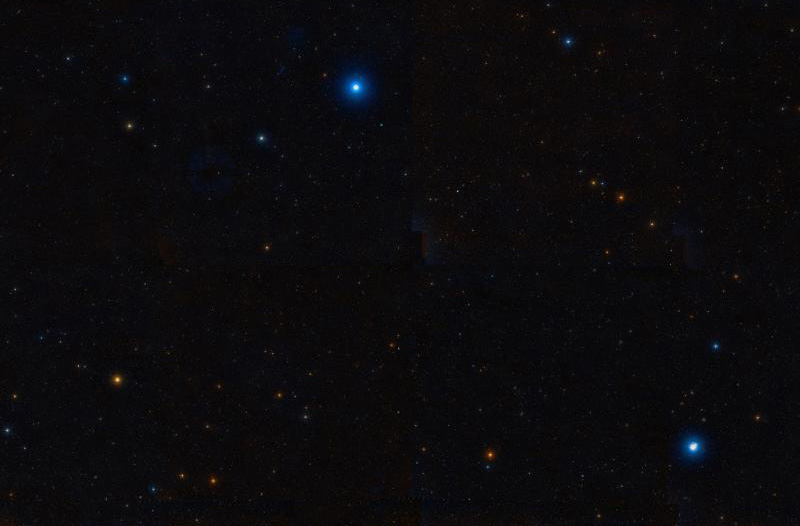
दू॒रम॒स्मच्छत्र॑वो यन्तु भी॒ताः। तदि॑न्द्रा॒ग्नी कृ॑णुतां॒ तद्विशा॑खे।
तन्नो॑ दे॒वा अनु॑मदन्तु य॒ज्ञम्। प॒श्चात् पु॒रस्ता॒दभ॑यन्नो अस्तु।
नक्ष॑त्राणा॒मधि॑पत्नी॒ विशा॑खे। श्रेष्ठा॑विन्द्रा॒ग्नी भुव॑नस्य गो॒पौ।
विषू॑च॒श्शत्रू॑नप॒बाध॑मानौ। अप॒ क्षुध॑न्नुदता॒मरा॑तिम्। ॥ १४ ॥
Dūram asmacchatravo yantu bhītāḥ |
tad indrāgnī kṛṇutāṃ tad viśākhe |
tan no devā anumadantu yajñam |
paścāt purastād abhayam no astu |
nakṣatrāṇām adhi patnī viśākhe |
śreṣṭhāv indrāgnī bhuvanasya gopau |
viṣūcaś śatrūn apabādhamānau |
apa kṣudham nudatām arātim || 14 ||
“Away may run from us [our] enemies in fear!
That Indra and Agni both should do [for us]!
That the two stars of Viśākhā ! That our sacrifice the gods should enjoy. May there be fearlessness in front and behind us.
For the two stars of Viśākhā are the Supreme Queens of [all] Nakshatras. [For] Indra and Agni are the best Guardians of the world! Driving away the enemies, May they push away the hostile hunger.”
Claws, Scales, and Arches: What the Fork?
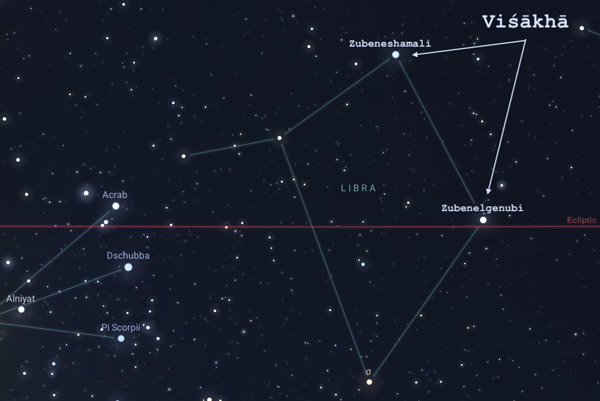
Libra (Tulā) is a zodiacal constellation in the southern hemisphere of the sky marked by four stars that form its Babylonian symbol, the balancing scales. Contrary to the scales of justice, the ancient Jyotiṣa sages believed Tulā to represent a town or busy marketplace, whose scales suggest the ability to negotiate and weigh value. Indeed, the noun tulā means “scales” in Sanskrit.
However, Jyotiṣa pre-dated the solar zodiacal constellations and instead used the marking stars for the 27 nakṣatras.[1] Looking at this area of the sky, the two bright stars that form the top of what would be regarded as the scales, were seen rather as the top part of a triumphal arch. Those two bright stars are the yoga tārās (marking stars) for the nakṣatra of Viśākhā.
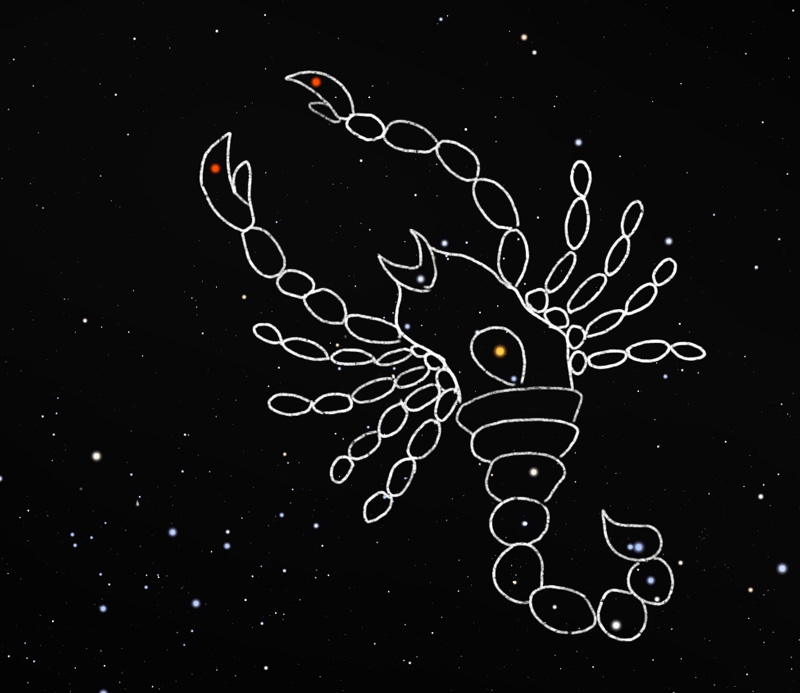
They are referred to in the star catalogue as Zubenelgenubi (Alpha Librae) and Zubeneschamali (Beta Librae). Their ecliptical longitude is 21°14' and 25°32' Libra, respectively. There are other stars in the area that complete the pictogram of a scale or an arch but these two are both bright (magnitudes of 2.75 and 2.60) and very close to the ecliptic. Indeed, the alpha star is only 20’ north of the ecliptic. This would render them quite visible to star gazers.
The outsized constellation of Scorpio, when imaginatively rendered, can be seen as reaching its claws out to encircle the smaller constellation of Libra. Indeed, the name of the two marker stars translates as the south and north claws of the Scorpion, though they are in the constellation of Libra. Viśākhā nakṣatra begins at 20°00' Libra and ends at 3°20' Scorpio. Its pratimā (symbol) is the aforementioned triumphal archway, signifying the potential for success and achievement in the lives of those natives who are born under this star.
The Fiery Road
The domination of the Scorpion in this part of the zodiac is significant and was discussed in the ancient Hellenistic tradition. The region from around 15° of Libra through the end of Scorpio was referred to as Via Combusta. Though it is not referenced as such in the available classics of Jyotiṣa, it can be integrated very effectively, as have other methods, especially from the Persian astrological system.[2] Any graha traversing this part of the sky deserves careful analysis. Why is this piece of real estate referred to as the fiery road?
Let’s begin by considering what is astrologically unique about Viśākhā. It happens that this is the only nakṣatra where five grahas are in some way exaggerated: Saturn exalts in the Libra portion where the Sun debilitates. Rahu and Ketu exalt in the last pada (quarter) of Viśākhā, which falls in Scorpio where the Moon debilitates. It certainly raises an eyebrow that the lights of the world, Sun and Moon, are diminished as they pass through this turbulent part of the zodiac. One can just feel the crackling of tension potentized from the disadvantaged luminaries and powerful malefics.
The intensity of the Scorpion’s claws gives Viśākhā natives the ability to focus and cling to their desires, but this must be met with an awareness of self and others for a smooth journey through this part of the cosmos and hence their lives.
Double Trouble or Two Are Better than One?
Just as a nakṣatra gives nuance to its allotted 13°20' of a particular zodiacal rāśi, each star has a unique symbol and deity that give clues to its deeper significance. The two deities associated with Viśākhā are Indra and Agni, or Indrāgni, a powerful God with one body and two heads. Out of 27 nakṣatras, only a few are given more than one deity, but unlike the others, this star is granted two of the most powerful lords, and most often praised in Ṛg Veda.
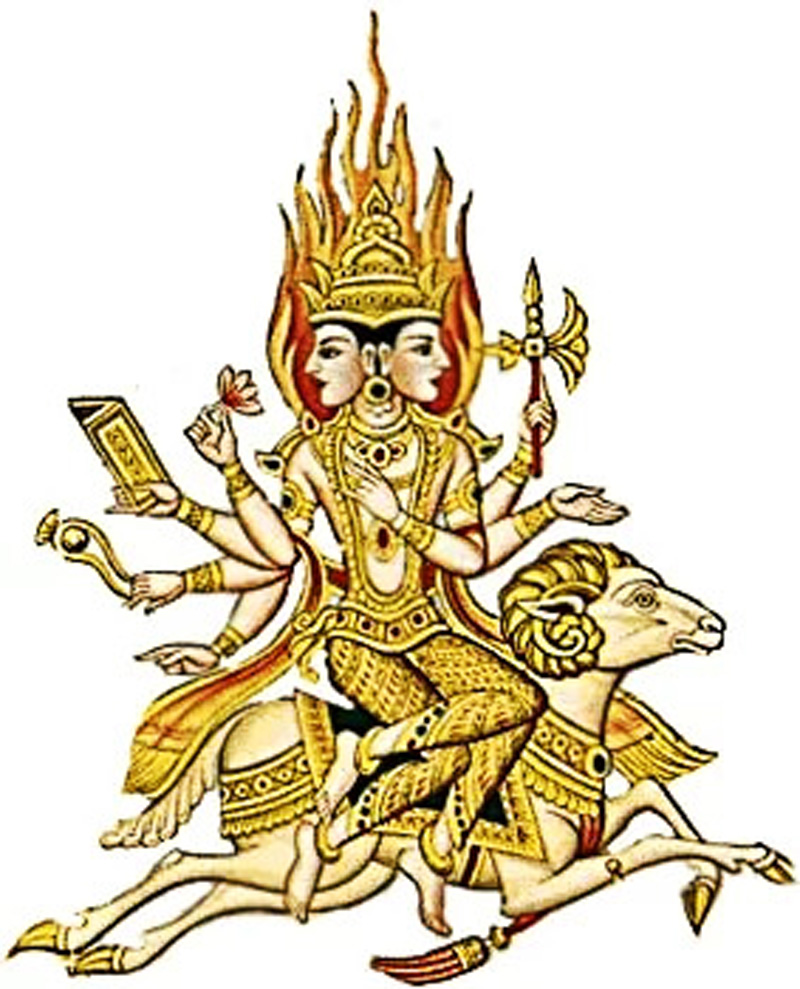
Indra, the king of the gods, rules over thunder and lightning and controls the rains and winds. He is best known for his superpower strength, victorious battles, and his ability to beat the odds. His success, however, is fraught with challenges of another kind, where he must ultimately overcome the inner struggles of ego, gluttony, addiction, pride, anger, and jealousy. Agni, the god of sacrificial fire, symbolizes transformation and renewal. He has two heads, a benefic one that transforms and purifies all it touches and a malevolent one that burns and destroys anything in its path. Agni’s insatiable desire coupled with Indra’s grasping and determination makes this one of the fiercest nakṣatras for worldly attainment, as revealed by its location in the scorpion’s claws. Together, these two powerful gods weave the themes that play out in Viśākhā natives’ lives.
Naturally, attainment requires Viśākhā natives to makes sacrifices and great effort toward their goals. Sacrifice means to rein in or abstain from a desire for the sake of something deemed more worthy. The Mahābhārata[3] tells the story of how Agni lost his ability to perform sacrificial rites. Known for his insatiable appetite, he found himself plump and sluggish from enjoying too many sacrificial offerings. He sought help from Brahmā who reprimanded him for his gluttony but gave him a chance to slim down, regain his strength, and restore blessings.
It was decided that Agni would help the Pāṇḍavas burn the overgrown Khāṇḍava forest so they could rebuild their kingdom, which would also be a way for Agni to satisfy his insatiable appetite. Having gotten wind of the news, Indra was concerned for his dear friend, Takṣaka, a great serpent king who dwelled in the forest. To save his life, Indra created great storms to defeat Agni’s efforts to burn the forest. Agni struggled to keep the fire ablaze and was forced to call upon Kṛṣṇa and Arjuna for help, after which a great battle ensued. Although there are many versions of this story, suffice it to say both Agni and Indra were successful. Indra’s superhero strength—with a little help from soma (the nectar of immortality) helped save his dear friend. And Agni, by way of his great efforts, purified his sins of gluttony from the past by helping the Pāṇḍavas clear the forest for a new kingdom.
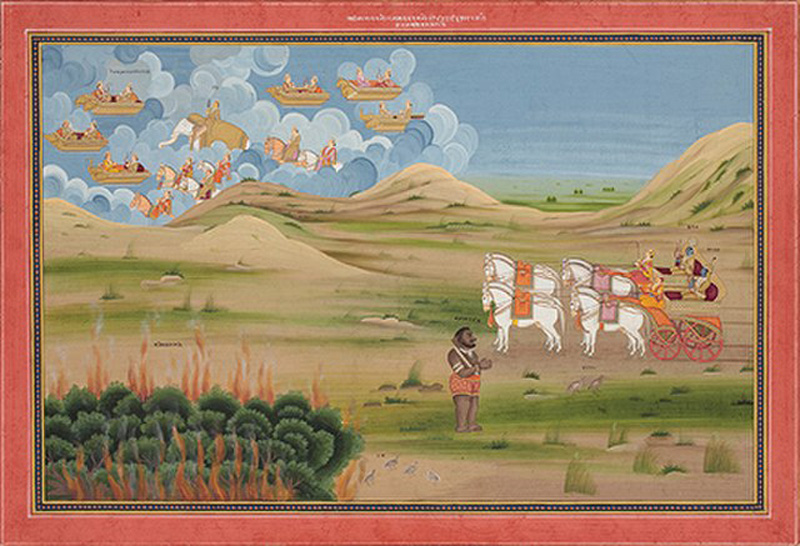
Although Indra used soma to gain confidence in battles that led to the good of mankind, he often overindulged in the elixir, leading to indiscretions—the cause of his many downfalls. His battle with ego and excess demonstrates how proper discrimination is necessary to master the impulses of the primal mind, even for a devata (deity). Agni illustrates the ability to undertake stiff penances if prodded in the right direction by a Guru or mentor, but the lesson is also to not relentlessly drive oneself without care for self or others. The tales of Indra and Agni serve to remind us that we must find the courage and strength to transform our lower natures, find balance, and choose the righteous path of dharma.
Understanding the deities gives a window into the deeper motivations of the Viśākhā native’s modus operandi. The following charts highlight some of the themes found in these stories.
The first example displays the obsessive, one-pointed focus of one man’s journey to overcome his addiction to alcohol that ultimately left a legacy that healed millions.
Lost Battles, Triumphant Return
The first example displays the obsessive, one-pointed focus of one man’s journey to overcome his addiction to alcohol that ultimately left a legacy that healed millions.
Bill Wilson November 26, 1895 03:00:00 East Dorset, VT, USA[4]
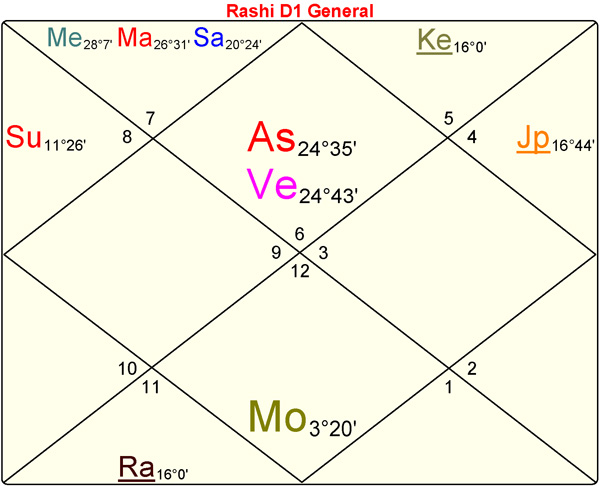
Bill Wilson was a co-founder of Alcoholics Anonymous (AA), an internationally known and highly successful program that was born out of his personal struggle with alcoholism. His chart reflects the themes of overindulgence that a Viśākhā native may succumb to under the right set of conditions in a birth chart. From the tale above, both Indra and Agni were known to have large appetites that led to pain and suffering.

“God, grant me the serenity to accept the things I cannot change, courage to change the things I can, and wisdom to know the difference.”
Wilson has a Virgo lagna with a debilitated second lord Venus exactly on the rising degree. Lagna lord Mercury in the second bhāva is highly afflicted by Saturn and Mars, two grahas that are kārakas (significators) for alcohol in addition to their other attributes as natural malefics. The second bhāva represents that which sustains one in life, including what comes in through the mouth e.g., food and drink. This gives confluence to patterns of overindulgence which, when tied to the second bhāva, can be through intake and in his case, alcohol.
Fortunately for Wilson, those same two grahas provide a way out. They are in each other’s rāśis creating a Mahāparivārtana[5] Yoga, with second lord, Venus, highlighting the importance of second bhāva themes in the native’s life. By virtual house swapping, Venus is as if in its own second bhāva, which gives it, and the second bhāva, some strength. However, at the same time, Venus becomes afflicted by those tandem malefics, Saturn and Mars.
Mercury coming back into its own lagna fares far better. Though flanked by malefics, it is now in its own first bhāva, a most advantageous configuration indicating an ability to utilize and learn from mistakes—including his use of alcohol to overcome his shyness. After initial setbacks, this yoga can give success, and in Wilson’s case, it granted a triumphant comeback fueled by lagna lord, Mercury, in very determined Viśākhā.
“Reaching the top is a monumental achievement but remaining there might be the most spectacular feat of all.”
He needed every bit of that determination as Saturn and Mars are not only natural malefics but each owns a difficult bhāva, the sixth and the eighth respectively. They clearly compromised Wilson’s ability to steer his life in a positive direction for a time. However, through the strength gained as a result of the Parivārtana Yoga and his drive to succeed, he miraculously found a new path—one of transformation, healing, and spirituality. Although an alcoholic, he simultaneously had an unwavering desire to find a cure and spent the first part of his life searching and experimenting with alternative healing modalities.
A strong marker for alternative healing is innovative Rāhu sitting in the sixth bhāva of health. However, Rāhu also comes with the baggage of being erratic and overcome with cravings. Which way will it tip? Under the care of a doctor with unconventional practices, his desire to find a cure led him to experiment with psychedelics as a treatment to break the compulsion to drink fueled by Saturn, Mars, and Rāhu. It was after having what he described as a “religious experience” while under the influence of psychedelic herbs in 1934 that he quit drinking and turned his life around.
Viśākha’s tenacity and drive to reach a goal were fueled in Wilson’s chart through the strength of the exalted grahas, Saturn and Jupiter. Although their exaggerated state can create too much of a good or bad thing, they do have dignity, and over time, if the proper effort is made, their positive qualities will shine.
The Mahāparivārtana Yoga also boosted the positive traits of Mercury. Considering the pile-up of malefics on the second bhāva and how they played out in his life, it took a powerful lagna lord to give him the skills and wherewithal to turn around his life. It was during a Ketu-Rāhu daśā-bhukti[6] that sobriety began for Bill and lasted until his death. Ketu sits in the twelfth bhāva of mokṣa, where one often finds God or some version of spirituality.
Agni is the God of deified fire and purification that leads these individuals toward transformation and purification. Wilson recovered from alcohol with a little help from his friends—and an exalted Jupiter in the eleventh bhāva of groups and clubs. Jupiter casts his gaze onto Wilson's Sun and Moon as if to awaken him to his true purpose in life.
“The comeback is always stronger than the setback.”
It was shortly after recovery that he discovered the importance of relying on a friend or having a support system when tempted to have a drink. Like Agni, success came both through others and his own resourcefulness. He devised a twelve-step system that is known today as Alcoholics Anonymous (AA). Its success lies in these three principles: It holds alcoholics accountable for their actions; provides a reliable support system from other alcoholics; and has a spiritual framework that reinforces a higher power.
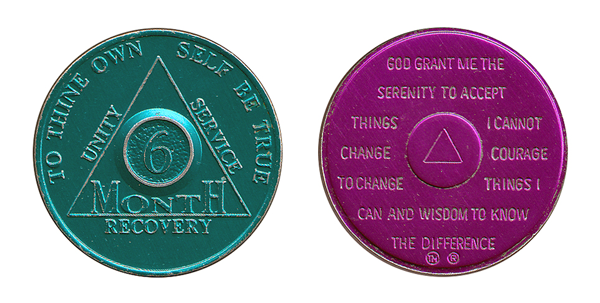
In many ways, this is the ultimate expression of Jupiter in his chart. With a remarkable second Mahāparivārtana Yoga between Jupiter and the seventh lord Moon in the house of partnerships, we see the highest expression of one-on-one relationships and fellowship. It also reveals Wilson’s nurturing side, full of compassion as he truly cared for others’ well-being. Having relinquished his ego to a higher power and purpose coupled with his resolve for recovery, Wilson had incredible success. He was honored by Time Magazine in 1999, as a Healer, In the Time 100: The Most Important People of the Century.
Upon reflection on the Serenity Prayer quoted above, I believe that Wilson’s efforts, sacrifice, and repeated prayer expressed the gifts of three key grahas in his chart: He found serenity in Saturn—which enabled him to accept his limitations, he had the courage to change the things he could—courtesy of Mars, and Jupiter gave him the wisdom to know the difference.
Agni is compelled by his voracious appetite to devour everything in his path. This translates in Viśākhā natives as incredible ambition. They have a seemingly endless list of goals they fixate on; once a goal is achieved, they move on to the next with little fulfillment, or worse, a wake of collateral damage as they may put all else second to reach their goals, depending on the disposition of the chart.
Last Woman Standing
Let’s look at the remarkable chart of a native who reached the highest pinnacle of success in her career echoing the great efforts characteristic of Agni while eschewing the norm of personal happiness through spouse and children.
Condoleezza Rice November 14, 1954 11:30 Birmingham, AL USA[7]
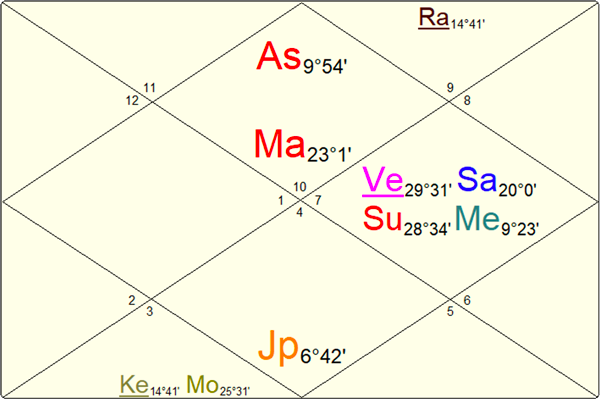

For a woman from humble beginnings, Condoleezza Rice’s achievement in politics is unmatched. Beating all the odds, a major theme for Viśākhā, she was the first African-American female to be Secretary of State, after being the first female to serve as National Security Advisor—both during the George W. Bush administration. These achievements followed her position as the first woman and first African-American Provost of Stanford University. She served on the boards of many major corporations in the U.S. and even has a 129,000-ton supertanker named after her!
A chart with a dizzying array of powerful grahas, there is simultaneously severe affliction to her conjugal life, which could be summed up nicely by the expression, “You can’t have it all.” Pushing aside all personal relationships, she never married or had a family.
Condoleezza’s sole focus on her career highlights the Viśākhā theme of success first, all else second. What immediately stands out about her chart are the three ucca (exalted) grahas located in kendras (angles). Four Mahāpuruṣa Yogas[8] found in one chart elevate this nativity to the stratosphere and is itself a rare Rāja Yoga[9]. Coupled with her lagna lord, Saturn, at its highest degree of exaltation (20 degrees Libra) in the tenth bhāva of visibility and success, her chart is the poster child for the highest echelons of achievement.
The Capricorn lagna itself, as the natural ruler of the tenth bhāva of career and one’s actions, is yet more confluence for her natural drive to want to reach the top—or as the pop song goes, “Work, Work, Work.” Moreover, the aforementioned lagna lord, Saturn, in the tenth bhāva creates a bevy of yet more Rāja Yogas[10]. And to drive the point home, Mars, the planet of drive and ambition, is ucca in the lagna stabilized by a beautiful expansive ucca Jupiter giving yet more drive, more success. Not that we need any more assurance that Rice is ambitious, but there are four grahas in the midheaven—the tenth bhava—including her ucca lagna lord, Saturn. Three of those grahas are in the nākṣatra, Viśākhā. This, of course, begs the question, is there a downside to too much Viśākhā?

This level of determination and one-pointedness can not only work against such natives by isolating them from important personal relationships or normal social obligations as seen in Rice’s life, they can also be resistant to input from others— the “don’t tell me what to do” syndrome. The latter issue played a big part in one of the glaring defects of her leadership—the Iraq war, based on false intelligence, which to this day she does not own up to.[11]
That she did not marry or have children can be seen in her chart by the location of the lord of the seventh, Moon, in the sixth bhāva afflicted by the Rāhu/Ketu axis, while Mars and Saturn aspect her seventh bhāva. The kāraka Venus, though powerful, is totally combust. That same combustion of Venus as the lord of the fifth bhāva of children also indicates that area of life might not fructify. She currently serves as Director of the Hoover Institution at Stanford University and is the recipient of several honorary degrees. One cannot scoff at her accomplishments or the courage she displayed to make it to the top in a mostly white-male–dominated field. Like Indra, she showed incredible courage and ambition to be successful but was also known to take incredible pride in her professional judgements, which mainly served her well but led to the Iraq war decision, which will tag her through history.
The Forked One
The Sanskrit word, Viśākhā, is composed of two root words: vi, meaning “with or toward,” and śākhā, meaning “branches,” or “with branches.” Śākhā can also imply the ability to “embrace, or pervade, having branches all over.” Vi can also mean, “no branches” or “two branches suggesting a sense of duality or being forked,” and “a branching off from the trunk, which requires one to find their own support system or to go it alone,” as we will see represented by our next Viśākhā native.
Elisabeth Kübler-Ross July 8, 1926 22:45 Zurich, Switzerland
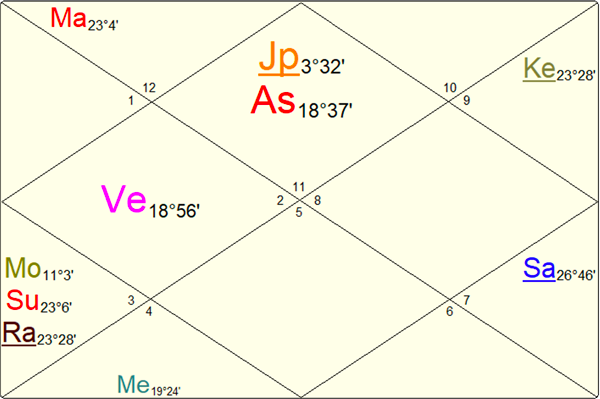
Elisabeth Kübler-Ross’s chart is a beautiful example of when Viśākhā’s traits of courage, determination, and accomplishment are executed to benefit mankind. One may immediately notice the strength of the two angular benefic grahas, Jupiter and Venus, utterly unafflicted. These natural benefics played a role in turning her scientific mind toward counseling and healing others, as benefic grahas tend toward an interest in humanity. With grace on her side, she found the resources and support needed to pursue her purpose and accomplish her goals.
Lagna lord Saturn’s placement in a dharma sthāna[12] pushed her idealistic Aquarian drive to educate and enlighten society. Both retrograde and exalted, Saturn, along with the support from Jupiter’s dṛṣṭi and stabilization of the first bhāva, gave her the determination and grit to explore a taboo subject that she felt desperately needed improving upon; a signature of retrograde grahas[13]. In this case, because both lagna and lord are strong, it gave her the stability needed to branch out on her own to accomplish something incredible.
Even the story of her birth, a preemie that had to fight to live, is a foreshadowing of her ambition and determination to make her mark in the world. Elisabeth was born weighing only two pounds. Prone to pneumonia, she was hospitalized at age five during which time she witnessed a fellow roommate die peacefully. It was this experience that sparked a lifelong pursuit to bring serenity and dignity to the process of dying.

As a determined youngster, she found work helping refugees and others who suffered the fallout from WWII and began working at the young age of 13. Her conservative father was adamantly against her desire to get an education and believed she was best suited as a secretary or maid. An exalted, retrograde Saturn in the bhāva of the father described that relationship and other difficulties but also gave her the will to persevere. Like Indra, she was not deterred by obstacles and found her way to success while helping those who were suffering and facing death. Lagna lord Saturn gave her a keen interest in death and dying as it is also ruler of the twelfth bhāva. Saturn’s lord, Venus, located in the fourth bhāva in a conservative, fixed rāśi exemplifies her father’s (and society’s) view of women during this time— that their true station in life was to be found at home. Against her parents’ wishes, Elisabeth left home at age 16 and volunteered and worked in a hospital leading her eventually to medical school.
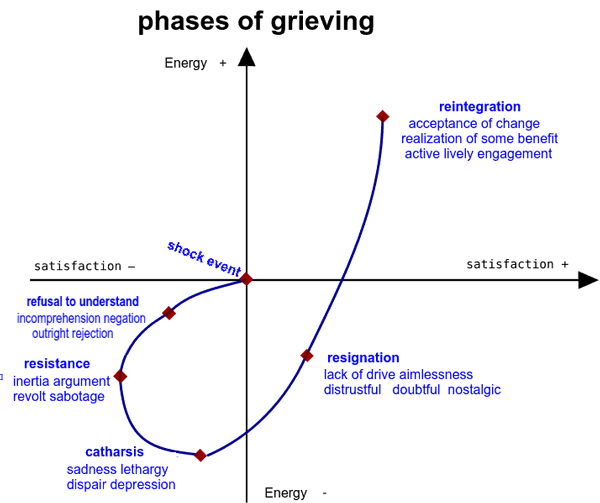
From that moment on, brilliant and powerful lagna lord, Saturn, in the bhāva of higher education afforded Ross the determination to accomplish her educational goals; she received an MD in psychiatry, not an easy feat during the 1950s. She fought her way to medical school only to face harsh criticisms from men in her field. Undeterred by the lack of support of others along the way, in 1969, her life’s work culminated in the publication of her best-selling book, On Death and Dying, an original treatise shedding light on the five stages of dying: denial, anger, bargaining, depression, and acceptance.
She shifted the whole paradigm with respect to care of the dying, she was an unparalleled pioneer in her field. She was not afraid to branch out to explore and bring to light an unpopular and taboo subject. Her incredible resoluteness and brilliance changed the medical field and public awareness. As a result of her overcoming the obstacles, what is now called hospice care, along with the new professions of death doulas, became mainstream—a triumphant culmination of her life’s mission.
Conclusion
The symbol, name, location, and deities of Viśākhā all have common themes of duality emphasizing the integration of two different energies, a branching out onto a new path or a choice to be made. All emerge as key themes for any native born under the influence of this nakṣatra. Perhaps the ancient star gazers placed Viśākhā in the grasping claws of the Scorpion because it marks the peak of material attainment but at the same time demands an inner transformation of one’s darker side, and a letting go, before success in granted. Based on the examples of the natives above, perhaps the symbol of the decorated archway covered by beautiful flowers symbolizes both the fruit of worldly attainment and the flowering of a spiritual path. The arch can be seen as a metaphor for both beginnings and endings, revealing the endless courage and single-mindedness it takes for these natives to reign victorious.
Author: Kristy Cohen

Kristy Cohen (CKYT, M.Ed) has studied Vedic Astrology, Hatha Yoga, and the Healing Arts passionately for the past 20 years. Much of her career focus has been on helping children develop self-care and mindfulness skills in yoga studios and public-school settings. She began her astrological studies with Penny Farrow at the Arsha Vidya Gurukulum Ashram, PA in 2014 and continues to pursue her passion for Jyotiṣa whether it be through studying, teaching, or counseling others.
Endnotes
[1] Farrow, Penny. 2020. "vedicchart.com." Cosmic Kaleidoscope Journal. September 9. Accessed May 12, 2021. https://vedicchart.com/cosmic-kaleidoscope-journal/what-you-see-is-what-you-get/.
[2] The integration of some Persian methods and Jyotiṣa has morphed into a unique branch of Jyotiṣa known as Tājika Jyotiṣa.
[3] n.d. "Adhi Parva." Chapter 12.
2005. "Apamnapat.com." Apamnapat.com. Accessed May 12, 2021. http://www.apamnapat.com/articles/Mahabharata016.html.
[4] n.d. "astrodatabank." astro.com. Accessed April 21, 2021. https://www.astro.com/adb-search.
[5] Mahāparivārtana Yoga is when lords of two positive bhāvas (1, 2, 4, 5, 7, 9, 10, and 11) occupy each other’s rāśi. It strengthens those two bhāvas in that they as if interchange places. Phaladīpikā 6:32
[6] Farrow, “Cosmic Duets: Enthralling Harmonies or Yowling Cats” in The Mountain Astrologer, June/July 2018 p. 18
[7] n.d. "astrodatabank." astro.com. Accessed April 21, 2021. https://www.astro.com/adb-search.
[8] The Pañcamahāpuruṣa Yogas (set of five yogas) are formed when a tāra graha (one of the five true planets) is in its svarāśi or exalted in a kendra or trikona. Phaladīpikā 6.1
[9] A chart with three or more grahas exalted or svarāśi in a kendra is a Rāja Yoga, a category of yogas that give kingship and in modern terms, preeminence. Phaladīpikā 7.1
[10] Rāja Yogas are said to confer kingship i.e., pre-eminence. There are countless varieties across almost all texts. Some have specific names but the vast majority are unnamed. The verses describe the rules in their formations.
[11] Memmot, Mark. 2011. npr.org. November 2. Accessed May 10, 2021. https://www.npr.org/sections/thetwo-way/2011/11/02/141933739/pre-iraq-war-intelligence-on-wmds-was-clear-condoleezza-rice-says.
[12] The first, fifth and ninth bhāvas constitute the dharma trine. These bhāvas align the native to natural law or right action.
[13] Sharma, Nikhil. 2020. "Cosmic Kaleidoscope Journal." www.vedicchart.com. September 9. Accessed May 12, 2021. https://vedicchart.com/cosmic-kaleidoscope-journal/exploring-the-enigma-of-a-retrograde-graha-through-the-lens-of-sastra.
Works Cited
n.d. "Adhi Parva." Chapter 12.
al., Hart de Fouw et. 1996. Light on Life. Twin Lakes, WI: Lotus press.
2005. "Apamnapat.com." Apamnapat.com. Accessed May 12, 2021. http://www.apamnapat.com/articles/Mahabharata016.html.
n.d. "astrodatabank." astro.com. Accessed April 21, 2021. https://www.astro.com/adb-search.
Dr. G.S. Kapoor, translation/commentary/annotation. 2020. Phaladīpikā. New Delhi: Ranjan Publications.
Farrow, Penny. 2018. "Cosmic Duets: Enthralling Harmonies or Yowling Cats." The Mountain Astrologer, June/July: 18.
—. 2020. "vedicchart.com." Cosmic Kaleidoscope Journal. September 9. Accessed May 12, 2021. https://vedicchart.com/cosmic-kaleidoscope-journal/what-you-see-is-what-you-get/.
Memmot, Mark. 2011. npr.org. November 2. Accessed May 10, 2021. https://www.npr.org/sections/thetwo-way/2011/11/02/141933739/pre-iraq-war-intelligence-on-wmds-was-clear-condoleezza-rice-says.
Sharma, Nikhil. 2020. "Cosmic Kaleidoscope Journal." www.vedicchart.com. September 9. Accessed May 12, 2021. https://vedicchart.com/cosmic-kaleidoscope-journal/exploring-the-enigma-of-a-retrograde-graha-through-the-lens-of-sastra/.

